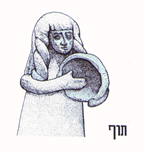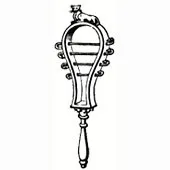March 14th, 2016
16. How does archaeology help in Bible translation?
Do archaeological materials and historical records sometimes help correct or improve Bible translations?
Yes, new archaeological information often helps correct or improve translations of terms that appear in the Bible. Here are a few examples.
Older translations often say that the furnishings in the temple were made of brass, probably because the furnishing on the translators’ church altars were brass. But analysis of metal objects from the biblical period, including coins, shows that objects with a copper base were made from some form of bronze. Pure copper is too soft to be used for utilitarian objects such as tools. EHV therefore there calls both biblical coins and furnishings bronze, not brass or copper. So although Hebrew uses the same word for copper and bronze, EHV calls the ore copper and the objects bronze.

Older and even more recent translations often refer to tambourines. But ancient pictures indicate that the instrument in question (Hebrew tof) was not a hollow circle with rattlers on it, which was meant to be shaken, but a small hand drum, meant to be struck. So EHV regularly refers to drums or hand drums. The Israelites did also have rattles, shaped somewhat like a baby rattle. This instrument is called a sistrum. It, of course, would be possible to combine both a drum and tambourine into one instrument.

The account in Exodus of Pharaoh’s army being overwhelmed by the Red Sea uses a word pair usually translated chariots and horsemen. Archaeological evidence is that mounted cavalry was not common until the Assyrian period, so this probably refers to chariots and charioteers.
Many translations refer to the two categories of alcoholic beverages in the Bible as wine and strong drink or some such term. Strong drink tends to make one think of distilled or fortified beverages like brandy or whisky. Evidence is that this type of production of alcoholic beverages was not part of the Near Eastern culture (though some dispute this). The two categories of alcoholic beverages in the Bible appear to be grape-based and grain-based. The current archaeological term for these ancient grain-based beverages is beer. The similarities and differences between ancient beer and our beers which descend from it is a study in itself, perhaps a topic for another FAQ. Since beer is the standard archaeological term for these ancient grain-based beverages, it is the term EHV will use.
Our final example will be given a more detailed treatment because it is a good example of how historians and bible scholars make mistakes and then try to blame the Bible for their mistake.
The Bible calls a people who appear in the patriarchal accounts in Genesis Hittites or descendants of Heth. These Hittites appear to be one of the Canaanite peoples of the land. In the late 19th and early 20th centuries newly discovered texts revealed a new rival of the Egyptians around the time of the biblical judges. They were an Indo- European people from central Anatolia (Turkey), that the historians named Hittites.
Much has been written about the Hittite-Egyptian rivalry, and these Hittites play a prominent role in ancient history books. These people moved into an area of Anatolia that had been called the land of Hatti, so the historians named them Hittites, on the basis of the apparently erroneous conclusion that these people were related to the Hittites in the Bible. They then pointed out that these Hittites rose to prominences in central Anatolia significantly later than the biblical dates for the patriarchal period. It was concluded that the biblical references to Hittites must be anachronisms based on confused memories of the Hittites that were introduced into biblical accounts, which historians claimed were written long after the heyday of the Hittites.
But there is a major problem with this explanation. The problem is that these Indo-European rivals of the Egyptians did not call themselves Hittites. They called themselves Neshians. When they competed with the Egyptians, they were relatively new arrivals in the land of Hatti in central Anatolia, where they displaced an earlier non-Indo-European people called Hattians. The Neshians keep the geographic name land of Hatti but did not call themselves Hattians or Hittites. The Neshians were given the name Hittites by scholars on the basis of the alleged similarity to the name Hatti to Hitti in the Bible. This error produced an apparent discrepancy between the biblical and historical description of “Hittites.” This discrepancy was not produced by the Bible. It was produced by the historians who erroneously stuck the tag Hittites on the Neshians.
About the Hittites the University of Pennsylvania’s archaeological magazine Expedition (January 1974) says:
The first thing to realize about the Hittites is that they are not Hittites. The sad fact is that we are stuck with an incorrect terminology, but it is too late to do anything about it now. This unfortunate situation came about as a result of several deductions made by earlier scholars which, though entirely reasonable at the time, have proved to be false….
We now know that these people we call Hittites were Indo-European. … It is now believed that the Hittites came into Anatolia sometime in the latter part of the third millennium B.C., though exactly when and from where are questions we still cannot answer.…
The Hittites were indeed a major world power in the period 1700-1200 B.C., but they were not Hittites. That is, they did not call themselves Hittites. They refer to themselves as Neshians, “inhabitants of the city Nesha,” and their language Neshian. But so much for that; the scholarly world had already labelled them Hittites and, like it or not, Hittites they shall forever remain. It is just as well, for the term Neshian only calls attention to our ignorance of this early period; we do not even know where Nesha is to be located….
There was the evidence all along: what we call Hittite should be called Neshian and the evidence for this had been available since 1887.
That is the simplified version of a complicated story. In EHV we considered calling the biblical Hittites Hethians to avoid the confusion historians have created. But since the biblical Hittites are the real Hittites and the historical Hittites are the imposters, we decided to keep the term Hittites along with the term descendants of Heth and to explain the problem with a brief note.